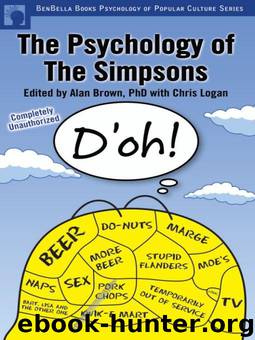Psychology of the Simpsons by Brown Alan S

Author:Brown, Alan S. [Brown, Alan S.]
Language: eng
Format: mobi, epub
Publisher: BenBella Books, Inc.
Published: 2010-09-13T04:30:00+00:00
Self-Discrepancy Theory
Regardless of its basis, it is clear that humans will go to great lengths to attain and preserve positive self-esteem. The mental gymnastics underlying changes in self-esteem are a longstanding research focus.
William James (1890) is responsible for psychologists’ general assumption that there are multiple levels of the self. Self-discrepancy Theory (Higgins, 1989) relies on this multiple selves idea. According to SDT, there are three important self-images which we all recognize: the actual self, the ought self and the ideal self. The actual self is comprised of perceptions of one’s own behaviors, habits, tendencies, traits, thoughts and feelings. The ought self, like a conscience, represents a personal guide to what we should or should not do, think or feel in any given situation. Finally, the ideal self represents what we would like to be or to achieve, ideally, in a world with no constraints. For example, a college student might ideally dream of being the valedictorian at commencement (ideal self). At the very least, though, the student feels the press to study for each test, work hard on each assignment and make those tuition payments matter (ought self). However, in reality, we all slip up, and this fictional student may sometimes skip class, fail to study and struggle to pass some classes (actual self). (We hope this example does not have a ring of familiarity.)
Discrepancies between the actual self and either the ideal or ought selves have implications for one’s emotional life. Actual-ought discrepancies cause high arousal emotions such as guilt and anxiety (e.g., when you forget to call your mother on her birthday). Actual-ideal discrepancies may cause low arousal emotions such as sadness or wistfulness (e.g., realizing that you probably are not good enough to make varsity football).
For the Simpsons, self-discrepancies are commonplace, particularly in the first few seasons when the show was more focused on moral lessons. When Lisa purposely sabotages a schoolmate rival’s diorama, the guilt drives her to hallucination (“Lisa’s Rival”). Even Bart is wracked with guilt after cutting off the head of the statue of Jebediah Springfield (“The Telltale Head”). In both cases, Lisa and Bart do something that they know they should not have done. In contrast, when dreams are shattered, it is sadness rather than guilt that results. For instance, Lisa becomes severely depressed when she is told that her fingers are too stubby to play saxophone professionally (“Separate Vocations”). She writes in her daily log that: “This will be my last entry, for you were a journal of my hopes and dreams. . . . And now, I have none.” Frequently, the Simpsons have anthropomorphized the interplay between the various selves by using the time-tested gag where an angel and a devil (perched on one’s shoulders) compete for influence. In other cases, Homer even argues with his own brain about a desired course of action, as in this scene from “Brother from the Same Planet”:
ADMINISTRATOR: And what are your reasons for wanting a Little Brother?
HOMER’S BRAIN: Don’t say revenge! Don’t say revenge!
HOMER: Uh, revenge?
HOMER’S BRAIN: That’s it, I’m gettin’ outta here.
Download
This site does not store any files on its server. We only index and link to content provided by other sites. Please contact the content providers to delete copyright contents if any and email us, we'll remove relevant links or contents immediately.
| Direction & Production | Genres |
| Guides & Reviews | History & Criticism |
| Reference | Screenwriting |
| Shows |
Robin by Dave Itzkoff(2383)
Head of Drama by Sydney Newman(2255)
I'm Judging You by Luvvie Ajayi(2150)
The Paranormal 13 (13 free books featuring witches, vampires, werewolves, mermaids, psychics, Loki, time travel and more!) by unknow(2052)
Ten by Gretchen McNeil(1830)
Single State of Mind by Andi Dorfman(1760)
#MurderTrending by Gretchen McNeil(1615)
Key to the Sacred Pattern: The Untold Story of Rennes-le-Chateau by Henry Lincoln(1594)
Merv by Merv Griffin(1563)
Most Talkative by Andy Cohen(1546)
This Is Just My Face by Gabourey Sidibe(1433)
Notes from the Upside Down by Guy Adams(1413)
The Hunger Games: Official Illustrated Movie Companion by Egan Kate(1389)
Springfield Confidential by Mike Reiss(1363)
Jamie Oliver by Stafford Hildred(1357)
Binging with Babish by Andrew Rea(1330)
Clarkson--Look Who's Back by Gwen Russell(1306)
The TV Writer's Workbook: A Creative Approach To Television Scripts by Ellen Sandler(1300)
Blue Planet II by James Honeyborne & Mark Brownlow(1236)
